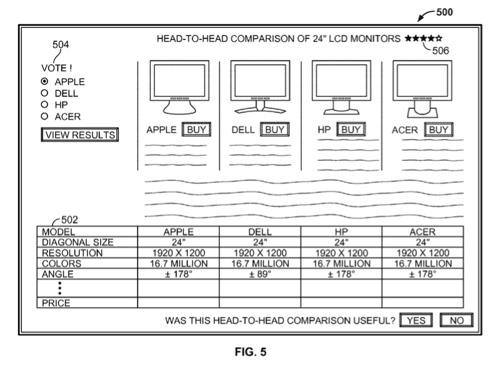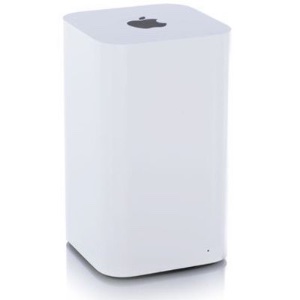Patent number 20110238699 at the US Patent & Trademark Office shows that Apple is working on head-to-head comparison features for its online stores.
The invention provides a comparison of a set of similar items includes: receiving from a first member of an online community a selection of a stored prior comparison created by another online community member of a set of similar items; providing to the first member a template for the comparison, the template being at least partially pre-populated using data from the stored prior comparison created by the other online community member; and receiving from the first member a submission of the comparison, wherein the comparison includes one or more modifications as made by the first member to the template. The inventors of the patent are Kenneth N. Chang, David A. Koski, Pedraum R. Pardehpoosh and Ralph E. Zazula.
Here’s Apple’s background and summary of the invention: “In the context of online stores, a user or potential customer of the store typically has for a particular type or class of item multiple different models from which to select. Different models may differ, for example, by available features, prices, manufacturers, etc. In some cases, administrators of an online store may provide comparisons of features and/or prices for different models of the same type of item to aid a user in the selection of a particular item.
“Such administrator supplied comparisons, however, typically do not include reviews on individual items and/or user feedback on items. A user of an online store may have access to reviews and/or feedback posted by others on individual items, but the user typically would have to expend time reading and sifting through the reviews for each individual item from a set of similar items under consideration to gain a sense of the pros and cons of each item. A single review and/or comparison of different models of the same type of item may exist from third parties (e.g., other web sites, magazine articles, etc.).
“However, a user or potential customer of the online store would have to locate such a review and/or comparison externally from the online store. It would be useful for a user of an online store to have access within an online store to side-by-side comparisons and reviews on a plurality of items of the same type. In addition, when making a decision on which item to select, e.g., for purchase, it might be useful to the user to receive, from someone who has knowledge and/or expertise on the type of item and who is not an employee or affiliate of the online store who may have an interest in selling an item and possibly not the best interests of the user in consideration, a recommendation on the best item in a set of similar items available at the online store.
“The invention can be implemented in numerous ways, including as a process, an apparatus, a system, a composition of matter, a computer readable medium such as a computer readable storage medium or a computer network wherein program instructions are sent over optical or communication links. In this specification, these implementations, or any other form that the invention may take, may be referred to as techniques.
“A component such as a processor or a memory described as being configured to perform a task includes both a general component that is temporarily configured to perform the task at a given time or a specific component that is manufactured to perform the task. In general, the order of the steps of disclosed processes may be altered within the scope of the invention.
“A detailed description of one or more embodiments of the invention is provided below along with accompanying figures that illustrate the principles of the invention. The invention is described in connection with such embodiments, but the invention is not limited to any embodiment. The scope of the invention is limited only by the claims and the invention encompasses numerous alternatives, modifications and equivalents.
“Numerous specific details are set forth in the following description in order to provide a thorough understanding of the invention. These details are provided for the purpose of example and the invention may be practiced according to the claims without some or all of these specific details. For the purpose of clarity, technical material that is known in the technical fields related to the invention has not been described in detail so that the invention is not unnecessarily obscured.
“Providing a comparison of a set of similar items is disclosed. In some embodiments, a selection of a set of similar items to be included in a comparison is received from a first member of an online community, and the comparison is stored so that the comparison can be presented to a second member of the online community when an indication is received that the comparison is of interest to the second member.
“In some embodiments, a ‘head-to-head comparison’ includes a comparison and/or review of a plurality of similar items or products. Such a head-to-head comparison may be useful, for example, to someone interested in purchasing a particular type of item but uncertain about which specific product to purchase. A head-to-head comparison can aid in making a decision about which item in a set of like items is the best or the best for a particular purpose or value.
“Allowing members of a relevant community, e.g., an online community (such as users of an online store), to create or define head-to-head comparisons that can be provided to other members of the community, e.g., other users or customers of the store in the case of an online store, when appropriate is disclosed. In many cases, the user community may represent a wealth of information about a set of similar items or products available, for example, from an online store (or other third party), and it would be useful to be able to provide a comparison of the set of similar items to other users.
“A user having some knowledge or expertise on a particular type of item may desire to create a head-to-head comparison that includes a plurality of items or products of that type. The author of a head-to-head comparison may include reviews and/or comparisons of various features associated with the items that are included in the head-to-head comparison as well as commentary on how the items differ.
“In some embodiments, the author may specify pros and cons of the items included in the head-to-head comparison. In some embodiments, the author may rank the items and/or indicate which item the author feels to be the best in the set of items included in the head-to-head comparison. In some such cases, the author may rank the items included in a head-to-head comparison differently based on the intended use of the items and/or may select different items to be the best for different uses or under different circumstances.
“In some embodiments, the items included in a head-to-head comparison are similarly priced. In some embodiments, a head-to-head comparison includes items that are differently priced, and in some such cases may include reviews that compare prices to features or performance. In some embodiments, similar items from different manufacturers are compared in a head-to-head comparison. In some embodiments, a head-to-head comparison includes multiple items from the same manufacturer.
“In some embodiments, when an author selects items to be included in a head-to-head comparison, a comparison grid including various features of the items selected is automatically generated and/or populated from product descriptions and/or specifications available at an online store so that the author does not have to supply such information when defining a head-to-head comparison. In some such cases, the author may have the ability to append to, delete from, modify, etc., information included in the automatically generated comparison grid.
“A head-to-head comparison created by one user of an online store may be useful to other users of the online store who are interested in the items and/or type of items included in the head-to-head comparison and may be presented to such an other user when an indication of interest in the items and/or type of items included in the head-to-head comparison is received.”
Also at the US Patent & Trademark Office is a new patent (number 20110238713) for per thread garbage collection. Objects associated only with a thread that created them are tracked. At a garbage collection time for a particular thread, it is determined which objects associated only with that thread remain reachable from a restricted root set associated with the thread. Any thread-only objects that are not determined to be reachable are garbage collected. The inventors are Gerald Blaine Garst Jr., Gregory Robert Parker, Douglas Joshua Behnke and Patrick C. Beard.
— Dennis Sellers



